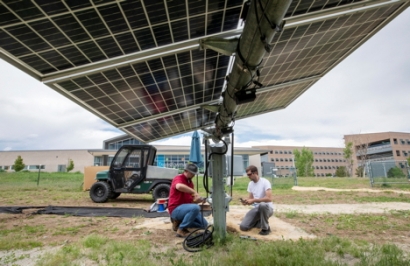
"The cells themselves are pretty much the same price," Chris Deline, NREL researcher and principal investigator on the study said. "You're going to a slightly more expensive package. You have to do something different on the backside—either glass or clear, transparent plastic. On the whole, it's going to be less than 10% more cost."
To determine how much more power such panels can produce, the team needed data, so they are gathering it. Some of their data are already publicly availablePDF—an industry first for a study of this scale. NREL researchers anticipate new data will remove barriers to advancing the cutting-edge technology by providing information and best practices that increase installation efficiency, reduce costs, and improve durability. So far, the results have not disappointed.
"Everybody is really excited because the results are returning in line with expectations," Deline said. "Compared with initial simulations, we're actually getting more energy out than was modeled."
Electricity from the Ground Up
During the current study, the team plans to evaluate the benefits of different ground covers beneath the solar panels. Since the bifacial PV energy gain relies on reflected light, the more the ground can reflect, the more powerful the panels.
"We look at ways of enhancing the ground albedo [the proportion of the incident light or radiation that is reflected by a surface, typically that of a planet or moon] through different treatment options like natural vegetation, crushed rock, and weed barriers," Deline said. "Some of that is already happening in industry, but this will be the first multiyear study with open data."
In the study's first year, Deline's team is testing natural ground cover. They will follow by adding crushed rock in the second year, and Deline said they are considering rolling out some kind of white fabric for a third comparison.
"We're seeing that as the grass turns brown, it gets more reflective," Deline said. "And snow cover is great."
With snow on the ground, when average albedo is several times more reflective than grass, all tested panels hit their highest recorded gains.
The team at NREL's Golden, Colorado, research site is working with commercial partners including Prism Solar, Sunpreme, and Lumos Solar—a supplier based in the nearby town of Nederland, Colorado—along with major international manufacturers. Leveraging relationships with a total of six companies, the lab will benchmark and compare mono- and bifacial panels from the same brands across multiple years.
The study's 10-row PV array follows the sun using NEXTracker's single-axis tracker technology, increasing the amount of direct sunlight that can be captured for energy. The higher energy production from each module means installations require less supporting hardware per megawatt, lowering what is known as the balance of system costs.
Deline and his team also paired the PV array with two Avalon Battery vanadium redox flow batteries. The batteries store energy generated during the day and make it available for use during higher evening demand.
That storage, along with the solar tracking technology, helps to level the system output. It relieves the steep, mid-day production peaks bookended by lower morning and afternoon generation that is commonly associated with traditional, stationary solar.
The study also supports material durability research in partnership with other research organizations through the Department of Energy's (DOE's) Durable Module Materials Consortium (DuraMAT).
"We're looking at module reliability on single-axis trackers, and specifically whether modules damaged during shipment, resulting in cracked cells, are still usable or deteriorate further when installed on single-axis trackers," Deline said.
With state-of-the-art computational modeling and predictive simulation capabilities, NREL's high-performance computing (HPC) resources reduce the risks and uncertainty that often limit progress on new and innovative technologies.
"We've drawn on the Eagle high-performance computer a lot recently," Deline said. "We're completing one-year performance simulations that would take four or five days on a laptop—in less than a minute on Eagle."
As a result, the team can maximize output for different configuration scenarios, including racking height, spacing, and even material choices such as black or reflective support framing. The simulations are open source, meaning others can use and build upon the datasets for future analyses.
"Our simulations start at the panel and fly photons back to where they intercept the sky dome—it's backwards ray-tracing and evaluates irradiance at the modules," Deline said. "All sorts of geometries are possible."
As a national laboratory with strong ties to industry, NREL is uniquely positioned to deliver the data, analysis, standards, and best practices these technologies require.
"By publishing on this, solar installers are going to see better terms on financing," Deline said. "Utilities are going to bring more consistent, renewable, and affordable energy into their generation mix."

